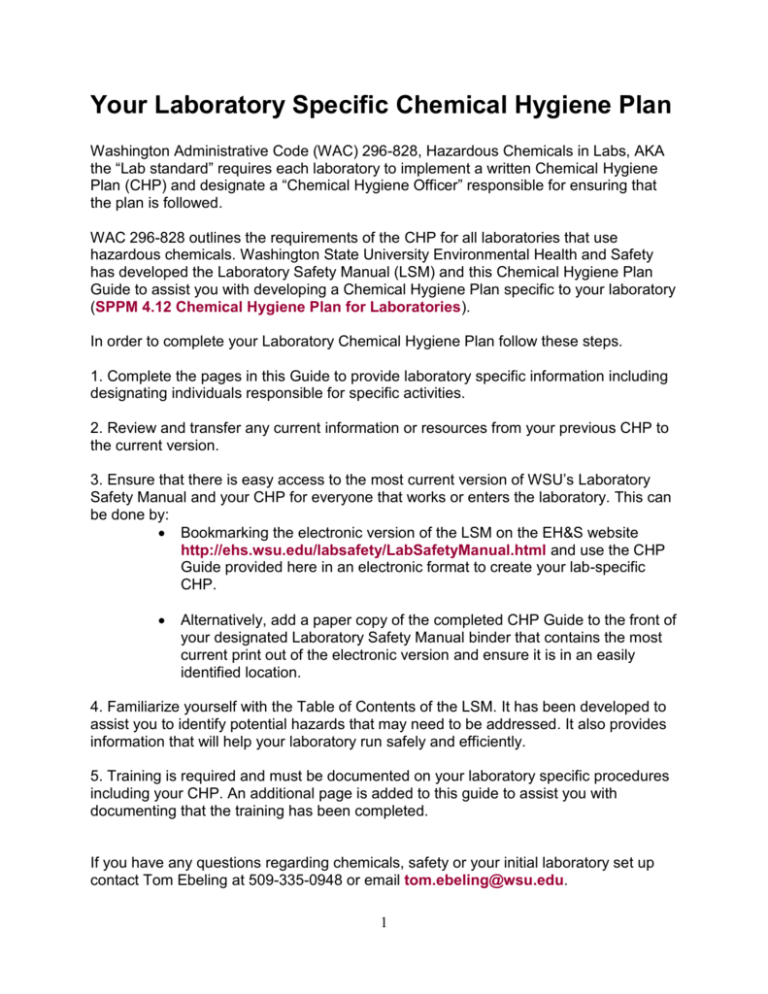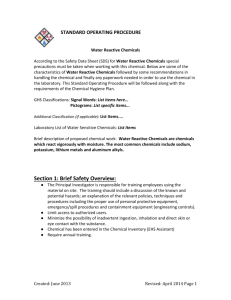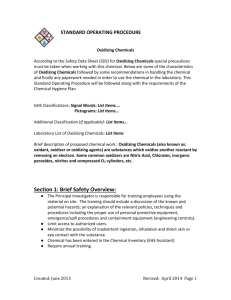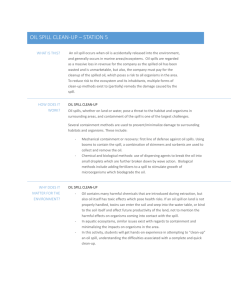CHP Site Specific Plan - WSU Environmental Health & Safety
advertisement

Your Laboratory Specific Chemical Hygiene Plan Washington Administrative Code (WAC) 296-828, Hazardous Chemicals in Labs, AKA the “Lab standard” requires each laboratory to implement a written Chemical Hygiene Plan (CHP) and designate a “Chemical Hygiene Officer” responsible for ensuring that the plan is followed. WAC 296-828 outlines the requirements of the CHP for all laboratories that use hazardous chemicals. Washington State University Environmental Health and Safety has developed the Laboratory Safety Manual (LSM) and this Chemical Hygiene Plan Guide to assist you with developing a Chemical Hygiene Plan specific to your laboratory (SPPM 4.12 Chemical Hygiene Plan for Laboratories). In order to complete your Laboratory Chemical Hygiene Plan follow these steps. 1. Complete the pages in this Guide to provide laboratory specific information including designating individuals responsible for specific activities. 2. Review and transfer any current information or resources from your previous CHP to the current version. 3. Ensure that there is easy access to the most current version of WSU’s Laboratory Safety Manual and your CHP for everyone that works or enters the laboratory. This can be done by: Bookmarking the electronic version of the LSM on the EH&S website http://ehs.wsu.edu/labsafety/LabSafetyManual.html and use the CHP Guide provided here in an electronic format to create your lab-specific CHP. Alternatively, add a paper copy of the completed CHP Guide to the front of your designated Laboratory Safety Manual binder that contains the most current print out of the electronic version and ensure it is in an easily identified location. 4. Familiarize yourself with the Table of Contents of the LSM. It has been developed to assist you to identify potential hazards that may need to be addressed. It also provides information that will help your laboratory run safely and efficiently. 5. Training is required and must be documented on your laboratory specific procedures including your CHP. An additional page is added to this guide to assist you with documenting that the training has been completed. If you have any questions regarding chemicals, safety or your initial laboratory set up contact Tom Ebeling at 509-335-0948 or email tom.ebeling@wsu.edu. 1 Laboratory Chemical Hygiene Plan (CHP) Principal Investigator (name) __________________________ Department __________________________ Building __________________________ Room(s) __________________________ 2 Responsibility for Chemical Hygiene and Safety Laboratory safety responsibilities are outlined in Washington State University’s Laboratory Safety Manual section I.D. Complete the following information for your Laboratory Specific Chemical Hygiene Plan. Person responsible for chemical hygiene and the Chemical Hygiene Plan in this laboratory (Principal Investigator, Faculty Member, or Supervisor): _____________________________________________________________________________ Name Title Room(s)1 covered by this plan: ______________________________________________________________________________ ______________________________________________________________________________ Implementation Date:___________________________________________ Annual Review Dates:___________________________________________ _______________________________________________________________ _______________________________________________________________ _______________________________________________________________ 1 The room(s) for which the Chemical Hygiene Plan is written must be adjoining rooms, a single room, or an area within a room as long as the Plan is accessible to all laboratory staff at any time, day or night. 3 Chemical Purchasing, Storage, and Dispensing Chemicals at Washington State University are generally purchased through University Stores and distributed by Central Receiving. See Laboratory Safety Manual section II.B for further information. Purchasing Chemicals delivered by University Stores will be delivered to (location): ____________________________________________________________________________ ____________________________________________________________________________ If chemicals are procured from vendors other than University Stores then special provisions may apply. If you will receive chemicals through an alternative method (following WSU Purchasing Policies) please describe it below. ____________________________________________________________________________ ____________________________________________________________________________ Some chemicals may require prior approval from the department or laboratory before their purchase due to specialized hazards, storage, or use requirements. List any chemical that requires prior departmental and/or laboratory approval for purchase. ______________________________ _____________________________ ______________________________ _____________________________ ______________________________ ______________________________ Storage Person who can accept chemicals and is responsible for the storage of the chemicals for this Laboratory (name and title): ___________________________________________________________________________ 4 Dispensing Generally, chemicals are delivered to, dispensed from, and used within, the same laboratory. If chemicals will be stored in another location and dispensed or picked up for use in the laboratory, describe the locations of the storage and dispensing of the chemicals below. ____________________________________________________________________________ ____________________________________________________________________________ 5 Secondary Labeling System The primary labeling for chemical containers is the original manufacturers’ labeling system. Secondary containers filled from the primary chemical container require labels so that occupants will be aware of the contents of the container. WSU’s Laboratory Safety Manual section II.H provides complete information on labeling requirements. Secondary containers are required to be labeled with (at the minimum): Chemical or common name Hazard warning (GHS, NFPA, HMIS system(s) or equivalent) If an alternative method of labeling (tags, shelf labels, etc.) is used please describe it below: ______________________________________________________________________________ ______________________________________________________________________________ ______________________________________________________________________________ _____________________________________________________________________________ The person(s) responsible for ensure all labeling is completed in this laboratory is (Name and title): ______________________________________________________________________________ ______________________________________________________________________________ 6 Safety Data Sheets (SDSs) Information on Safety Data Sheets is provided in WSU’s Laboratory Safety Manual section II.M. Describe where current SDSs can be found for the chemicals used in your laboratory. Online SDSs are located at the web address: ______________________________________________________________ Hard copies of SDSs are located in (building, room number, and description of binder): _______________________________________________________________________ _______________________________________________________________________ The person(s) responsible for maintaining SDSs: _______________________________________________________________________ Name title SDSs for this lab may be obtained from: _______________________________________________________________________ Name title 7 Standard Operating Procedures for Particularly Hazardous Substances Standard Operating Procedures (SOPs) are required for the use of particularly hazardous substances (including chemicals) that are used in the laboratory. Particularly hazardous substances include hazardous chemicals, nanomaterials, explosive materials, lasers, biological, radioactive materials and other substances as defined by WAC 296-828. Contact EH&S at 3353041 for assistance. Laboratory Safety Manual section IV.C provides direction on creating and documenting SOPs. Copies of the SOPs for these materials should be kept with the Laboratory CHP. Describe where SOPs are stored. ____________________________________________________________________________ Person responsible for developing and maintaining SOPs for this laboratory (Name and title) ____________________________________________________________________________ 8 Chemical Spill Information Chemical Spill Clean-Up and Reporting Chemical Spill Clean-Up By Employees Employees can clean-up minor chemical spills ONLY when all of the following conditions are met: The chemical is known and the spill can be cleaned-up in ten minutes or less. Employees are trained to safely clean-up chemical spills. Employees can wear the same personal protective equipment that they wear during normal work activities. Appropriate clean-up supplies are readily accessible. The chemical does not have a Ceiling Limit listed in WAC 296-841 or can create an Immediate Danger to Life and Health (IDLH) atmosphere. IDLH information can be found in the NIOSH Pocket Guide to Chemical Hazards. Clean-up materials are disposed of per SPPM 5.66. Chemical cleanup may be only conducted by trained personnel. Training is conducted by: ______________________________________________________________________ Name and title of person(s) responsible for spill cleanup training Instructions concerning specific chemical clean-up procedures are located in the Standard Operating Procedures for the chemical or provided during spill response training. Person(s) Trained to Clean-up Spills (name and title): ______________________________________________________________________ ______________________________________________________________________ ______________________________________________________________________ Mercury Spills Employees cannot clean-up mercury spills. EH&S responds to all mercury releases; call 3353041 during business hours and 335-9000 after business hours. 9 When to Call 911 If any of the above conditions cannot be met, then immediately evacuate all personnel from the area and call 911. Qualified emergency response personnel will respond to clean-up the spill. Recommended Spill Clean-Up Kit Each laboratory should assemble a chemical spill clean-up kit consisting of: Personal protective equipment normally worn during routine work (e.g., gloves, safety goggles, lab coat) Absorbent pads One-gallon Ziploc bags Dust pan and brush Duct tape Five-gallon bucket with lid The five-gallon bucket can be used to store spill clean-up materials and then can used to store contaminated items, such as gloves and absorbent pads, used during the clean-up. Once the spill is cleaned up the bucket is to be closed and labeled as Dangerous Waste. Submit an on-line Chemical Collection Request form at http://forms.ehs.wsu.edu/Main.aspx and EH&S will pick-up the container. Location of Chemical Spill Kit: __________________________________________________________________________ Instructions for Re-stocking Chemical Spill Kit: Restocking materials may be obtained from University Stores. Or (describe alternate procedure): __________________________________________________________________________ __________________________________________________________________________ 10 Site Specific Ventilation Information WSU’s Laboratory Safety Manual section III describes fume hood certification, general ventilation, and maintenance and repair requirements for WSU facilities. Describe any additional ventilation requirements or usage in your laboratory (i.e. fume hood sashes must be left open at all times, snorkel procedures, clean benches procedures): ______________________________________________________________________________ ______________________________________________________________________________ ______________________________________________________________________________ ______________________________________________________________________________ ______________________________________________________________________________ ______________________________________________________________________________ ______________________________________________________________________________ ______________________________________________________________________________ ______________________________________________________________________________ ______________________________________________________________________________ ______________________________________________________________________________ ______________________________________________________________________________ ______________________________________________________________________________ ______________________________________________________________________________ ______________________________________________________________________________ ______________________________________________________________________________ ______________________________________________________________________________ ______________________________________________________________________________ 11 Diagram of Laboratory Layout (Emergency wash facilities, first aid kits, fume hoods, biosafety cabinets, flammable storage cabinets, refrigerators, exhaust, fire extinguishers, bench tops, and other means of controlling work flow) 12 Certificate of Employee Training Name and title of person providing laboratory safety training: ___________________________________________________________________________________ The following employees have received laboratory safety training and reviewed the chemical hygiene plan for this laboratory. Name Date trained ________________________________ ______________________________ ________________________________ ______________________________ ________________________________ ______________________________ ________________________________ ______________________________ ________________________________ ______________________________ ________________________________ ______________________________ ________________________________ ______________________________ ________________________________ ______________________________ ________________________________ ______________________________ ________________________________ ______________________________ ________________________________ ______________________________ ________________________________ ________________________________ ________________________________ ________________________________ ________________________________ ________________________________ ________________________________ ______________________________ 13









